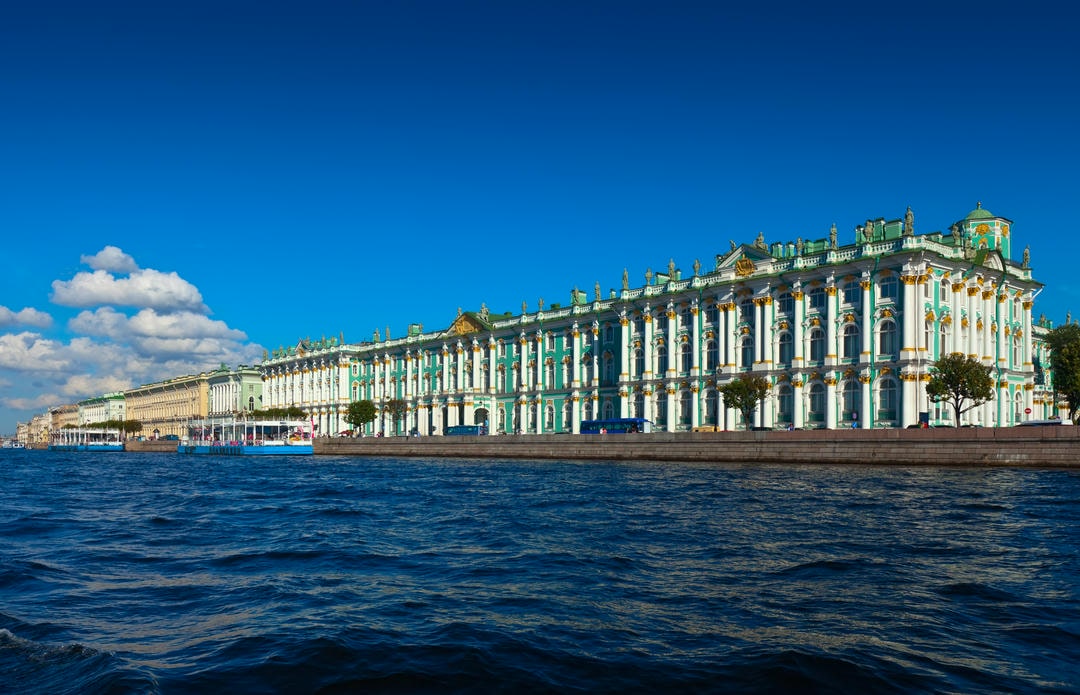The profound affinity Russians hold for cats is an intriguing aspect of their cultural identity, with nearly 60% of households sharing their lives with these enigmatic creatures. Far from mere pets, cats in Russia are emblematic of wisdom and fortune, interwoven into the very fabric of daily life and folklore. Celebrated annually on March 1st, National Cat Day underscores their esteemed status. This deep-rooted reverence, reflected in Russian literature, art, and urban settings, prompts an exploration into how these animals have sustained such a revered role throughout history. What drives this enduring bond between Russians and their feline companions?
Introduction
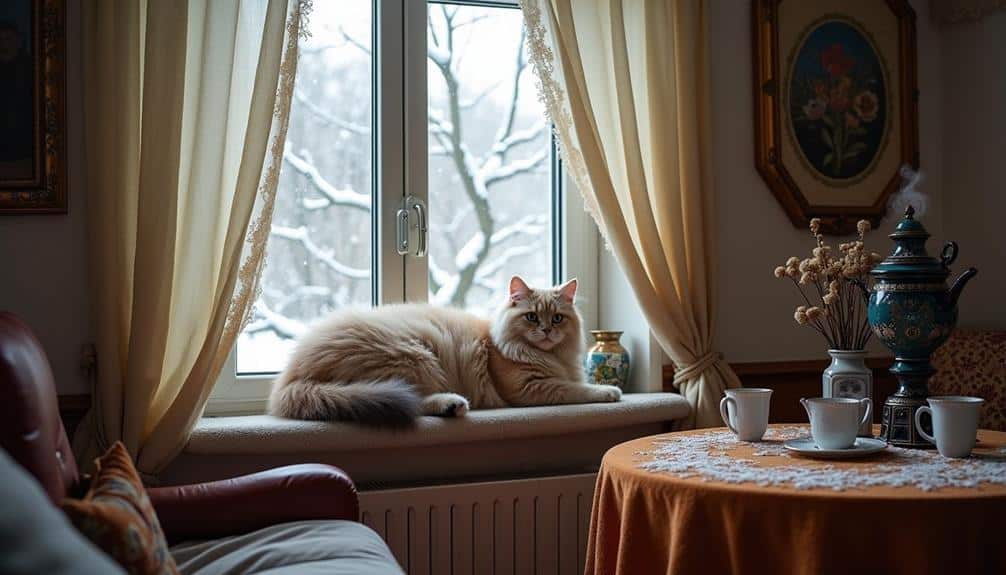
The profound bond between Russians and their pet cats is a multifaceted cultural phenomenon, deeply embedded in the nation’s historical and social fabric.
With an astonishing 60% of the population owning at least one feline, this affinity reflects both practical and symbolic dimensions, such as the perception of cats as harbingers of wisdom and good fortune.
This enduring relationship underscores the unique role cats play in Russian households and society at large.
Cats: Russian companions through history
Amidst the vast tapestry of Russian culture, the bond between people and their pet cats stands out as a unique and enduring relationship.
Cat related traditions, such as the belief in cats bringing good fortune, permeate the cultural fabric of Russia. These traditions are reflected in the widespread celebration of cat-themed events, which highlight the significance of felines in Russian society. National Cat Day on March 1st is a prime example, a day dedicated to celebrating the joy cats bring into Russian homes.
Popular cat breeds, such as the Siberian and the Russian Blue, are cherished for their resilience and companionship, perfectly suited to the harsh Russian winters.
Ethnographic studies reveal that feline health tips are commonly shared among cat owners, emphasizing the communal aspect of cat care and the collective knowledge that sustains these pets’ well-being.
Cat adoption stories are frequently shared in Russian media, showcasing heartfelt connections and the transformative power of pet ownership.
This profound bond is evident in the way Russians integrate cats into their daily lives, further solidifying the role of these animals as not just pets, but integral family members.
Russians’ love for cats deeply rooted
Rooted in both historical reverence and practical necessity, Russians’ love for cats is a deeply ingrained aspect of their cultural identity. Historically, cats have been cherished for their symbolic representations of wisdom and good fortune. This cultural affinity is evident in cat ownership trends, with Russia boasting the highest rate of feline companions globally. Approximately 60% of Russian households include at least one cat, underscoring their importance in daily life.
The benefits of feline companionship are manifold. Cats are known to offer significant health benefits, such as reducing stress and improving heart health, which are highly valued in Russia’s often harsh climatic conditions. Urban cat shelters thrive in major cities, reflecting a societal commitment to the well-being of these animals.
Additionally, cat grooming practices are meticulously maintained, ensuring the health and comfort of these beloved pets. Pet therapy programs are also on the rise, utilizing the calming presence of cats to improve mental health in hospitals and care homes.
This multifaceted appreciation for cats not only highlights their role as cherished companions but also emphasizes the practical and therapeutic advantages they bring to Russian society.
Significance of Cats in Russian Culture
The cultural significance of cats in Russia is deeply intertwined with historical beliefs and superstitions, where they are often considered harbingers of luck and guardians of the home.
Superstitions suggest that a cat entering a new home first can bring good fortune, reflecting a widespread belief in their protective qualities and companionship.
These notions are not merely archaic but continue to influence contemporary Russian society, integrating cats into the fabric of daily life and cultural practices.
Historical beliefs and superstitions about cats
Although cats are cherished globally, their cultural significance in Russia is particularly profound, influenced by a rich tapestry of historical beliefs and superstitions. Russian ancient folklore is replete with tales of mythical creatures where cats often play central roles. These feline beings were not just pets but revered as guardians and symbols of protection.
In Slavic mythology, the cat was believed to possess supernatural abilities, often viewed as a conduit between the human world and the spirit domain. Superstition beliefs surrounding cats have profoundly shaped Russian cultural practices. For instance, black cats, often shunned in other cultures, are considered harbingers of good fortune in Russia. This divergent view underscores the unique feline symbolism that permeates Russian society.
Cats were historically kept in monasteries and homes, believed to ward off evil spirits while ensuring prosperity and wisdom. Ethnographic detail reveals that cats were integral to household rituals, such as predicting weather changes and safeguarding the home.
These cultural practices reflect a deep-seated reverence for cats, rooted in centuries-old traditions. Indeed, the historical beliefs and superstitions surrounding cats in Russia highlight their enduring cultural significance, far beyond mere companionship.
Cats symbolize luck in new homes
Many Russians hold the belief that introducing a cat into a new home brings good luck and prosperity. This custom is deeply embedded in the cultural fabric and hinges on cat superstitions that have persisted through generations. The ritual of allowing a cat to be the first to enter a new dwelling is seen as a harbinger of good fortune and domestic harmony.
It is thought that the feline’s natural curiosity and grace can ward off negative energies, ensuring a positive start for the household. Feline rituals in Russia often involve specific practices, such as placing a cat in the center of a room to let it explore freely.
The notion is that the cat’s movements will set a harmonious tone for the new home, fostering a sense of well-being. These beliefs are not merely anecdotal but are echoed in various ethnographic accounts, illustrating the depth of the cultural context.
In essence, the practice of welcoming a cat into a new home serves as a symbolic gesture. It reflects a broader understanding of cats as creatures capable of influencing human fortune, weaving a tapestry of tradition that underscores the importance of domestic harmony in Russian life.
Cats offer protection and companionship
Beyond the practice of welcoming cats into new homes for good luck, these animals hold a deeper cultural significance in Russia as enduring symbols of protection and companionship. In Russian households, cats are revered not just for their ability to ward off evil spirits—a belief rooted in folklore—but also for their protective instincts in practical terms, such as guarding against pests. This concept of feline guardianship is intertwined with the emotional support these animals provide.
In the cold, often isolating climates of Russia, cats offer companionship benefits that extend beyond mere presence. Their symbolic presence as guardians of the home and hearth is complemented by their role in providing comfort and emotional well-being. The affection and warmth they bring can alleviate feelings of loneliness, making them indispensable companions for many Russians.
Moreover, the cultural context of cats in Russia is enriched by their portrayal in literature and art, where they often symbolize independence and resilience. This duality—protective instincts paired with emotional support—highlights the multifaceted roles cats play in Russian society, cementing their status as both pragmatic household protectors and cherished companions.
Cats in Russian Literature and Art
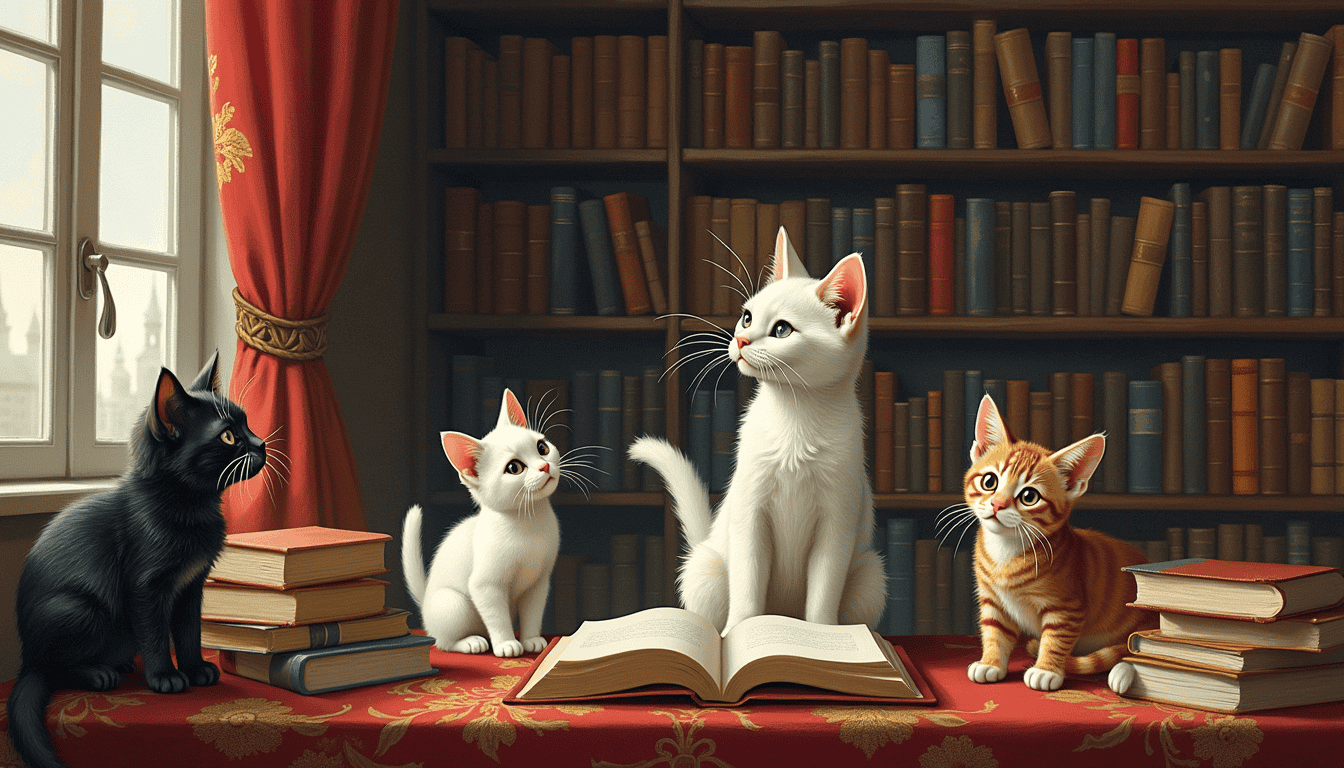
The representation of cats in Russian literature and art underscores their symbolic significance and the cultural affection Russians hold for these animals.
From the mischievous Behemoth in Bulgakov’s “The Master and Margarita” to the serene feline portraits by artist Olga Suvorova, cats are portrayed as complex and multifaceted beings.
Their presence in these works not only enhances narrative depth and visual richness but also reflects broader societal values and the intimate connection between Russians and their feline companions.
Representation of cats in Russian literature
In Russian literature and art, cats occupy a significant and multifaceted role, serving as both symbolic and practical elements in storytelling and visual representation. The use of cat symbolism is pervasive in Russian literary works, often embodying themes of mystery, independence, and wisdom. This is evident in the feline folklore that permeates Russian culture, where cats frequently appear in fairy tales and folktales as both magical beings and shrewd tricksters.
Literary cats in Russian narratives are not merely ornamental; they serve as narrative motifs that drive plots and elucidate deeper cultural values. For instance, Mikhail Bulgakov’s “The Master and Margarita” features Behemoth, a large, talking cat, whose antics are both humorous and unsettling, reflecting the chaotic nature of the world Bulgakov portrays.
Similarly, the poetic musings of Alexander Pushkin often include feline imagery, infusing his verses with a sense of grace and enigma.
Ethnographically, the portrayal of cats in Russian literature reflects broader societal attitudes towards freedom and autonomy, qualities that resonate deeply with a population that values independence.
These narrative elements underscore the enduring fascination Russians have with their feline companions, both real and imagined.
Portrayal of cats in Russian art
Artistic depictions of cats in Russian culture provide a vivid lens through which to examine the nation’s collective consciousness and values. Cat symbolism is deeply embedded in Russian historical artworks, where felines often represent mystery, independence, and protection. This can be seen in the ornate frescoes of ancient churches and the rich tapestries of the Tsarist era, where cats are depicted as guardians of sacred spaces and homes.
Feline legends also play a significant role in Russian art. Stories of magical cats that bring luck or ward off evil are frequently portrayed in folk art and traditional crafts. These legends are not merely whimsical tales but reflect deeper cultural beliefs about the protective and mystical qualities attributed to cats.
Artistic representations of cats are also prominent in cultural festivals, where they serve as motifs in costumes, masks, and decorations, highlighting their enduring significance in Russian society.
Modern Russian artists continue this tradition, capturing the enigmatic essence of cats in various mediums, from paintings to sculptures. Consequently, the portrayal of cats in Russian art is a representation of their profound and multifaceted role in the cultural and historical fabric of the nation.
Famous Russian works depicting cats
While exploring the significance of cats in famous Russian works, one cannot overlook their profound cultural impact, particularly in literature and art.
Literary felines have long been woven into the fabric of Russian traditions, serving as potent symbols and beloved characters. In Mikhail Bulgakov’s “The Master and Margarita,” the character Behemoth, a giant, talking black cat, embodies feline folklore and satirical wit, highlighting the complex layers of cat symbolism in Russian literature.
Cats also find their place in the works of renowned poet Alexander Pushkin, where they often symbolize mystery and independence—qualities deeply valued in Russian society. These literary felines not only enrich the narratives but also reflect the cultural appreciation for feline companionship, a sentiment shared by many Russians.
In art, cats frequently appear as subjects, from the whimsical illustrations of Yuri Vasnetsov to the modernist interpretations of Natalia Goncharova.
These artistic representations further underscore the integral role cats play in Russian cultural identity. Through the lens of literature and art, the enduring fascination with cats reveals a deeper connection to Russian traditions, where these enigmatic creatures symbolize freedom, wisdom, and the warmth of home.
The Role of Cats in Urban Life
In urban Russia, cats are a ubiquitous presence, often seen roaming freely through city streets and residential areas.
This integration extends into the cultural fabric of urban life, with many cafes and restaurants adopting feline mascots, thereby enhancing the ambiance and attracting cat-loving patrons.
Additionally, the acceptance of cats in various public spaces reflects a broader societal tolerance and affection, underscoring their significant role in the daily lives of urban dwellers.
Cats roaming freely in cities
The urban landscapes of Russian cities are distinctly characterized by the presence of cats roaming freely through streets, parks, and courtyards, a phenomenon deeply embedded in the cultural and social fabric of the nation. This stray cat culture is not merely a facet of urban life but a reflection of the unique relationship between Russians and their feline counterparts.
Urban feline behavior in Russia illustrates adaptability and resilience, as these cats navigate complex city environments while forming intricate city cat communities.
Ethnographically, these free-roaming cats are often viewed as communal pets, receiving care and affection from various residents. Public cat safety, however, remains a concern as these animals face threats from traffic, harsh weather, and occasional human hostility.
Despite these challenges, many urban dwellers take steps to guarantee their well-being by providing food, shelter, and medical care.
Feline socialization challenges arise as these cats must balance independence with occasional human interaction, shaping unique behavioral patterns. The integration of these cats into the urban milieu reflects broader cultural values of independence and connection, encapsulating a harmonious coexistence between humans and animals within Russia’s urban tapestry.
Growing popularity of cat cafés
How has the integration of cats into café and restaurant culture reshaped urban life in Russia? The rise of cat cafes has markedly influenced Russian urban culture, offering a unique blend of companionship and leisure.
These establishments, inspired by cat cafes abroad, serve as communal spaces where patrons can enjoy a meal or coffee in the company of felines. Such venues often host cat themed events, such as feline fashion shows and adoption fairs, which foster a sense of community and promote animal welfare.
The cultural context behind this phenomenon is deeply rooted in Russia’s historical affinity for cats. By incorporating cats into the social fabric of urban life, these cafes enhance the city’s vibrancy and diversity.
They also align with burgeoning pet therapy programs, providing emotional support and reducing stress for visitors. This symbiotic relationship benefits both the cats, many of whom are rescued and up for adoption, and the patrons, who find solace in their presence.
Through ethnographic detail, it becomes clear that these cafes are more than just trendy spots; they are microcosms of a society that values freedom, companionship, and well-being, encapsulating the essence of contemporary Russian urban life.
Acceptance of cats in public places
Against the backdrop of Russia’s historical affinity for felines, the acceptance of cats in public places illustrates a nuanced cultural dynamic that intertwines tradition with modern urban life. This phenomenon is manifest in various ways, from cats in transportation to the burgeoning popularity of feline fashion trends.
Public cat etiquette in Russia is often rooted in respect and adoration, reflecting a society where cats are seen as more than mere pets but as integral elements of the community.
Cat themed festivals, such as the annual National Cat Day on March 1st, highlight this acceptance, drawing thousands of participants who celebrate their beloved companions through parades and art exhibitions. Urban cat art further underscores this cultural thread, with murals and installations honoring these creatures adorning cityscapes across Russia.
Moreover, the presence of cats in transportation systems, such as the Moscow Metro, where stray cats are often adopted and cared for by staff and commuters, underscores a collective embrace of feline-friendly policies.
This integration of cats into public life not only provides practical benefits but also enriches the urban experience, fostering a sense of freedom and communal spirit among citizens.
Cat Cafés and Their Popularity
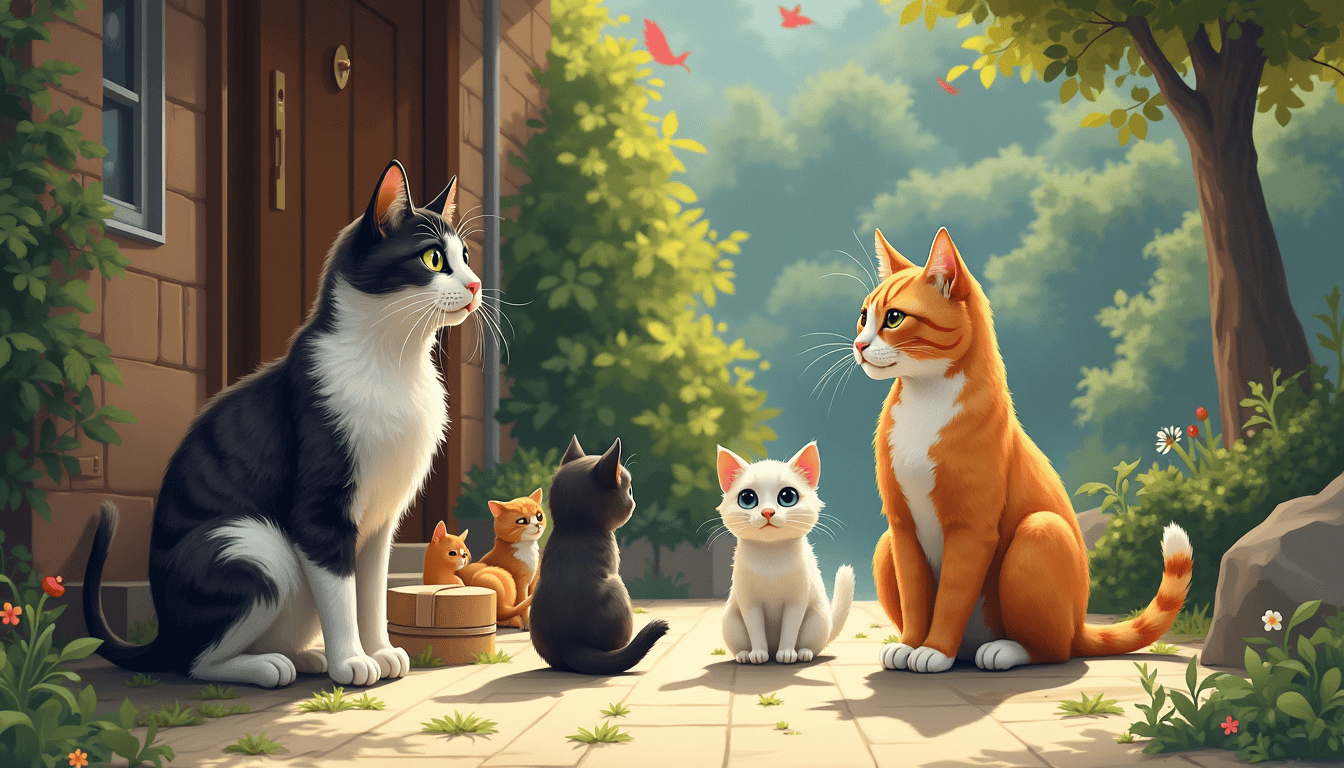
The rise of cat cafés in Russia highlights the nation’s love for felines, transforming these venues into lively social spaces where cat enthusiasts can relax and interact with cats. These cafés not only offer a unique leisure experience but also promote cat adoption and welfare by partnering with local shelters to find homes for abandoned cats.
Cat cafés have quickly become a cultural phenomenon in urban Russia, reflecting a sophisticated blend of social and cultural elements. They celebrate feline companionship through art exhibitions, themed merchandise, and wellness workshops, showcasing the evolving relationship between Russians and their cats.The appeal of these cafés is amplified by Russia’s long winters and dense urban environments, providing warm spaces for patrons to engage with cats. Community events foster connections among cat lovers, reinforcing the cafés as cultural hubs that highlight local artists and craftspeople.
Cat cafés serve as dynamic social spaces where patrons can share their passion for felines, offering emotional healing through cat therapy. They host discussions on pet psychology and themed gatherings, creating a sense of community among cat lovers.
Moreover, these cafés play a crucial role in promoting responsible cat adoption. By creating a stress-free environment for potential pet owners to interact with adoptable cats, they enhance awareness of cat welfare and the responsibilities of ownership. Overall, cat cafés in Russia embody a blend of cultural appreciation and social interaction, deepening the bond between humans and cats.
Context of Cats in Russian Society
The historical significance of cats in Russian society can be attributed to their essential role in hygiene and pest control, especially in agrarian and urban settings where rodent populations threatened food supplies and public health.
This practical utility has fostered an enduring affection for cats throughout Russian history, embedding them deeply within the cultural fabric.
Iconic examples, such as the revered feline residents of the Hermitage Museum, underscore this longstanding bond, highlighting the intersection of practicality and cultural esteem.
Cats and their role in hygiene and pest control
Historically, a significant aspect of Russian society’s relationship with cats has been their invaluable role in hygiene and pest control. In urban environments, where close quarters and limited ventilation can exacerbate issues of cleanliness, cats have been essential allies. Their keen hunting instincts and agile cat behavior make them adept at controlling rodent populations, which in turn mitigates the spread of diseases. This pest control function has been a critical hygiene benefit, particularly in densely populated areas.
Ethnographic studies reveal that Russians have long understood the link between feline health and the overall well-being of their living spaces. A healthy cat is an effective hunter, contributing to a cleaner and more sanitary environment. This practical approach to cat ownership is deeply ingrained in the cultural fabric, where cats are not merely pets but also guardians of the household.
Moreover, the urban environments of Russian cities, with their unique architectural and climatic challenges, have further highlighted the importance of cats. By maintaining a balance in the ecosystem, these felines have played a pivotal role in ensuring that homes and public spaces remain hygienic and free from pests, thereby enhancing the quality of urban life.
Enduring affection for cats throughout history
An appreciation for cats in Russian society is deeply interwoven with the nation’s historical and cultural tapestry. From the days of the Tsars, cats have held a distinguished place, often serving as royal pets in the palaces of Russian nobility. Historical anecdotes recount how Empress Elizabeth, daughter of Peter the Great, maintained a feline court, reflecting the elevated status these animals enjoyed. This royal patronage extended to the masses, embedding cats into the cultural ethos.
Feline folklore in Russia is rich and varied, with urban legends portraying cats as guardians against evil spirits and harbingers of good fortune. These stories have transcended generations, contributing to a national ethos where cats are seen as protectors and symbols of prosperity. The celebration of cat festivals, such as National Cat Day on March 1st, further underscores the deep-rooted affection Russians harbor for their feline companions.
Even during Soviet times, when much of traditional culture was suppressed, the love for cats persisted. Today, the legacy of this affection manifests in the ubiquitous presence of cats in Russian homes, museums, and public spaces, illustrating an enduring bond that transcends mere companionship.
The Russian Blue Cat: A National Treasure
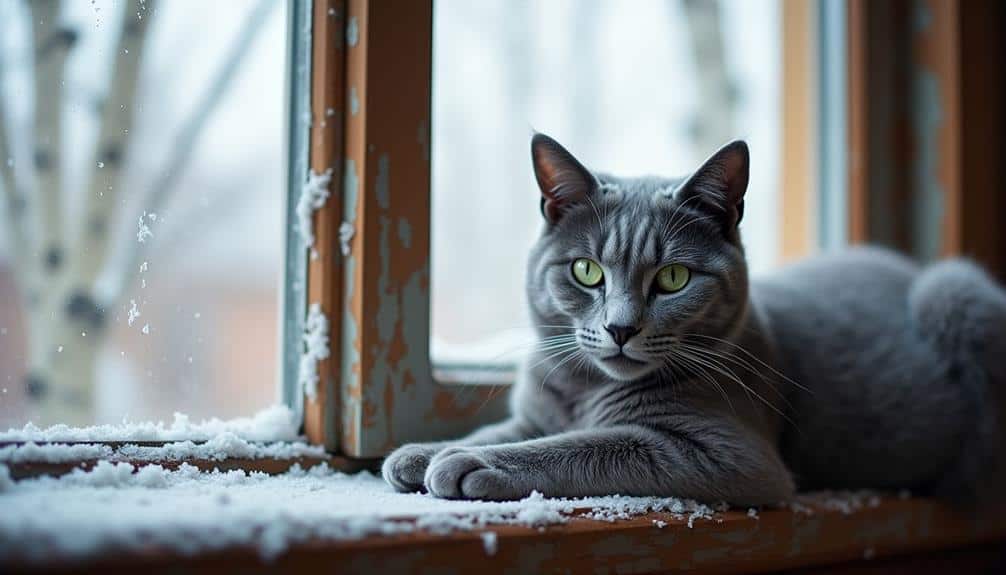
The Russian Blue cat, renowned for its striking blue-gray coat and emerald green eyes, holds a special place in Russian cultural heritage.
Originating from the Archangel Isles, this breed symbolizes elegance and tranquility, attributes that resonate deeply within Russian society.
The national pride in the Russian Blue is evident in its frequent depiction in Russian folklore and art, embodying the country’s profound reverence for feline grace and companionship.
Characteristics and history of the Russian Blue breed
Renowned for their striking appearance and serene demeanor, Russian Blue cats hold a special place in the hearts of cat enthusiasts worldwide, yet their roots are deeply embedded in Russian culture. Known for their plush, silvery-blue coats and vivid green eyes, these felines boast a regal aesthetic that captivates many. A product of their environment, the Russian Blue is believed to have originated in the port city of Arkhangelsk, where their dense fur served as protection against Russia’s harsh, cold climate.
Breed characteristics of the Russian Blue include a gentle, intelligent personality and a proclivity for cleanliness, making them highly sought after in cat care communities. Their reserved nature and quiet demeanor contrast with their playful and affectionate behavior towards familiar humans, showcasing a complex blend of feline behavior traits.
However, adopting a Russian Blue can present challenges, particularly due to their sensitivity to environmental changes and the need for mental stimulation to prevent boredom.
Understanding the Russian Blue involves appreciating their historical and cultural significance in Russia. The breed’s evolution is intertwined with Russian society, where they have been cherished not just for their beauty but also for their companionship, reflecting a deeper cultural affinity for these enigmatic creatures.
The cultural significance of the Russian Blue in Russia
From an analytical perspective, Russian Blue cats epitomize a unique cultural symbol deeply embedded in Russian society. This breed, renowned for its striking blue-grey coat and almond-shaped green eyes, has become emblematic of Russian feline folklore and cultural heritage.
The Russian Blue’s breed characteristics—such as its gentle demeanor, intelligence, and serene presence—are often celebrated in Russian literature and art, reinforcing its status as a national treasure.
In Russian folklore, cats are imbued with profound symbolism, often associated with wisdom, protection, and good fortune. The Russian Blue, in particular, is revered for its mystical aura and perceived ability to ward off negative energies. Historical accounts suggest that these cats were once regarded as guardians of the home, a belief that has permeated Russian cultural narratives for centuries.
This cultural reverence extends beyond mere folklore; the Russian Blue is also a prominent figure in Russian cultural heritage. Featured in various cultural artifacts, from folklore tales to modern media, the breed serves as a living reflection of Russia’s deep-rooted appreciation for feline companions.
Consequently, the Russian Blue stands not only as a beloved pet but also as a potent symbol of Russia’s rich cultural tapestry.
The endearing national cat breed
Beyond its symbolic significance in folklore, the Russian Blue cat embodies a profound source of national pride and affection among Russians. Esteemed for its striking beauty and gentle temperament, this breed is celebrated in various cultural contexts, from local cat festivals to the online presence of cat influencers who elevate its status globally. The Russian Blue’s sleek, silvery coat and vibrant green eyes are not merely aesthetic traits but markers of a heritage deeply cherished by its admirers.
Culturally, the reverence for the Russian Blue extends to breeding practices that prioritize maintaining the breed’s purity and health. Russian breeders meticulously adhere to standards that emphasize genetic integrity, ensuring the continuation of this national treasure.
Concurrently, feline rescue initiatives highlight a societal commitment to safeguarding these beloved cats, reflecting broader values of compassion and responsibility.
Cat festivals across Russia serve as public platforms where the Russian Blue is showcased, fostering a communal sense of national pride. These events often feature competitions and exhibitions, further entrenching the breed’s esteemed status.
Through these multifaceted engagements, the Russian Blue cat remains a potent symbol of Russian identity and cultural pride.
Cats as Companions
The role of cats as companions in Russian households is a fascinating interplay of cultural tradition and practical living. This phenomenon is deeply entrenched in the fabric of Russian society, where feline psychology plays a significant role in shaping human-animal interactions.
Cats, known for their independence and low-maintenance nature, resonate with the Russian ethos of resilience and self-reliance. Cat training in Russia often emphasizes mutual respect rather than dominance, reflecting a broader cultural appreciation for autonomy.
Nutritional needs are meticulously attended to, with Russian pet owners often opting for high-quality, locally-produced cat food. This attention to diet is not just about health but also about honoring the bond between human and feline.
Adoption challenges, however, remain prevalent, as animal shelters endeavor to rehome numerous stray and abandoned cats. Breed differences further complicate this landscape, with certain breeds like the Russian Blue being highly sought after, while mixed-breed cats often face neglect.
In essence, the Russian love for cats as companions transcends mere pet ownership. It is a nuanced, culturally rich relationship that reflects broader societal values and the practicalities of urban living in a country known for its harsh climates and close-knit communities.
Conclusion
The profound relationship between Russians and their cats is deeply embedded within the cultural, historical, and social fabric of the nation. This enduring bond is evident in literature, art, and urban settings, highlighting the symbolic significance of cats as icons of wisdom and fortune. The integration of cats into daily life, including the popularity of cat cafés and the revered status of breeds like the Russian Blue, underscores their central role in Russian society and cultural identity.



